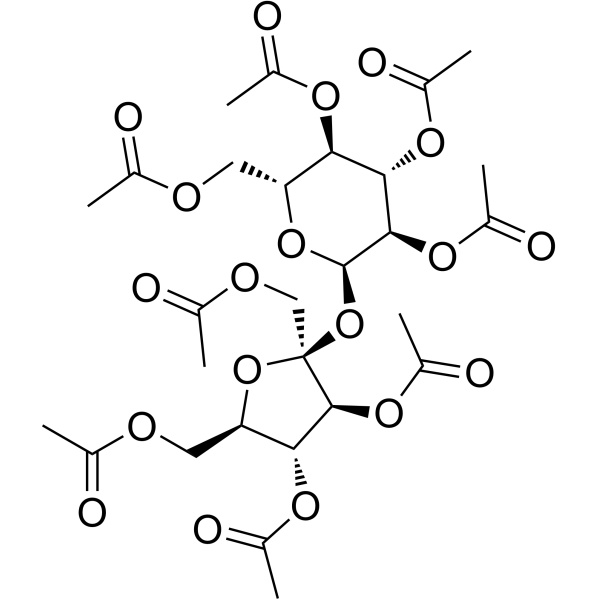
Sucrose octaacetate
CAS No. 126-14-7
Sucrose octaacetate( —— )
Catalog No. M26829 CAS No. 126-14-7
Sucrose octaacetate is an acetylated derivative of sucrose and can be used as a food additive, binder, and plasticizer.
Purity : >98% (HPLC)
 COA
COA
 Datasheet
Datasheet
 HNMR
HNMR
 HPLC
HPLC
 MSDS
MSDS
 Handing Instructions
Handing Instructions
| Size | Price / USD | Stock | Quantity |
| 100MG | 35 | In Stock |


|
| 200MG | Get Quote | In Stock |


|
| 500MG | Get Quote | In Stock |


|
| 1G | Get Quote | In Stock |


|
Biological Information
-
Product NameSucrose octaacetate
-
NoteResearch use only, not for human use.
-
Brief DescriptionSucrose octaacetate is an acetylated derivative of sucrose and can be used as a food additive, binder, and plasticizer.
-
DescriptionSucrose octaacetate is an acetylated derivative of sucrose and can be used as a food additive, binder, and plasticizer. Sucrose octaacetate is also used in many pesticides, insecticides, and other toxic products as a deterrent to accidental poisoning.(In Vitro):Sucrose octaacetate is nontoxic and has a number of uses based on its bitter taste. Polyaniline (PANI) nanofibers and nanorods are obtained using 2 and 3 g Sucrose octaacetate, respectively. The nanostructures containing irregular-shaped agglomerates, such as particulate particles and scaffolds are observed with increasing the concentrations of Sucrose octaacetate. The presence of Sucrose octaacetate during polymerization could only induce a change in morphology, but could not influence the molecular structure of the resulting PANI. Compared with those derived with 1, 3, and 4 g Sucrose octaacetate, the polymerized PANI from 2 g Sucrose octaacetate possesses higher thermal stability and electrical conductivity due to its higher crystallinity and highly ordered structure . (In Vivo):No recombination has been found between the Sucrose octaacetate-avoidance phenotype and PRP haplotype in any mouse population. To assess the latter possibility, two type-A, proline-rich protein genes (MP2 and M14), situated approximately 30 kb apart at the Prp locus, are separately transferred from a Sucrose octaacetate-taster inbred strain (SWR) to a Sucrose octaacetate-nontaster inbred strain (FVB). Five MP2-transgenic mice and seven M14-transgenic mice are insensitive to 1 mM Sucrose octaacetate in two-bottle tests, thus retaining the nontaster FVB phenotype .
-
In VitroSucrose octaacetate is nontoxic and has a number of uses based on its bitter taste. For example, sugar is rendered too bitter is eat at a concentration of 0.06% (w/w) Sucrose octaacetate. Sucrose octaacetate can form 255 different possible isomers and degradation products, all of which have a very low molar absorptivity. Polyaniline (PANI) nanofibers and nanorods are obtained using 2 and 3 g Sucrose octaacetate, respectively. The nanostructures containing irregular-shaped agglomerates, such as particulate particles and scaffolds are observed with increasing the concentrations of Sucrose octaacetate. The presence of Sucrose octaacetate during polymerization could only induce a change in morphology, but could not influence the molecular structure of the resulting PANI. Compared with those derived with 1, 3, and 4 g Sucrose octaacetate, the polymerized PANI from 2 g Sucrose octaacetate possesses higher thermal stability and electrical conductivity due to its higher crystallinity and highly ordered structure.
-
In VivoNo recombination has been found between Sucrose octaacetate-avoidance phenotype and PRP haplotype in any mouse population. Soa and Prp, therefore, are either very near each other or identical. To assess the latter possibility, two type-A, proline-rich protein genes (MP2 and M14), situated approximately 30 kb apart at the Prp locus, are separately transferred from a Sucrose octaacetate-taster inbred strain (SWR) to a Sucrose octaacetate-nontaster inbred strain (FVB). Five MP2-transgenic mice and seven M14-transgenic mice are insensitive to 1 mM Sucrose octaacetate in two-bottle tests, thus retaining the nontaster FVB phenotype. Expression of mRNAs for both type-A Prp genes alone or together do not enhance SOA taste sensitivity in nontaster mice.
-
Synonyms——
-
PathwayOthers
-
TargetOther Targets
-
Recptor5-HT1| β2-adrenergic receptor
-
Research Area——
-
Indication——
Chemical Information
-
CAS Number126-14-7
-
Formula Weight678.593
-
Molecular FormulaC28H38O19
-
Purity>98% (HPLC)
-
SolubilityIn Vitro:?DMSO : 100 mg/mL (147.36 mM)
-
SMILESCC(=O)OC[C@H]1O[C@@](COC(C)=O)(O[C@H]2O[C@H](COC(C)=O)[C@@H](OC(C)=O)[C@H](OC(C)=O)[C@H]2OC(C)=O)[C@@H](OC(C)=O)[C@@H]1OC(C)=O
-
Chemical Name——
Shipping & Storage Information
-
Storage(-20℃)
-
ShippingWith Ice Pack
-
Stability≥ 2 years
Reference
1.P?tsch MS, et al. The anabolic catabolic transforming agent (ACTA) espindolol increases muscle mass and decreases fat mass in old rats. J Cachexia Sarcopenia Muscle. 2014 Jun;5(2):149-58.
molnova catalog



related products
-
Danmelittoside
Danmelittoside is a natural product.
-
Bax - BH3
Bax - BH3
-
Euphorbia factor L7a
Euphorbia factor L7a is a natural product.



 Cart
Cart
 sales@molnova.com
sales@molnova.com


